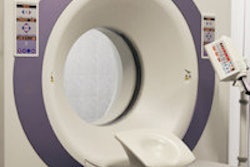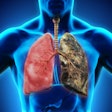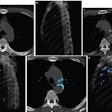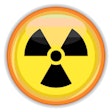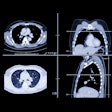A new analysis of data from the National Lung Screening Trial (NLST) has found that CT lung cancer screening is more effective for older smokers than younger ones. The study, published online Tuesday in the Annals of Internal Medicine, is sure to shape the roiling debate over whether Medicare should pay for CT lung screening.
CT screening was more effective in older smokers based on criteria such as the number needed to screen to prevent one lung cancer death and screening's positive predictive value, according to researchers from the U.S. National Institutes of Health (NIH). While screening-related harms such as false positives were slightly higher in the older subjects, the NIH group did not consider them excessive, especially when weighed against the benefits of screening.
"In the NLST population, the harms were marginally a little more prevalent in the over-65 group, but not by very much," said lead author Paul Pinsky, PhD, in an interview with AuntMinnie.com. "The potential benefits seemed to be similar in terms of the proportion of screen-detected cancers that were getting curative surgery, and the survival with screen-detected cancers was pretty similar in the two groups."
Message to MEDCAC?
The impetus for the study was last April's Medicare Evidence Development and Coverage Advisory Committee (MEDCAC) meeting, in which panel members voted against recommending Medicare coverage for CT lung cancer screening. The panel's decision shocked the medical community, especially as it flew in the face of a positive recommendation by the U.S. Preventive Services Task Force (USPSTF) several months earlier.
MEDCAC had several doubts about screening's efficacy, such as whether the high-quality medical environment at the 33 NLST centers would resemble real-world practice settings, and whether there might be more invasive procedures once the research was finished. MEDCAC also worried about evidence gaps regarding older screening subjects, as individuals 64 years and older constituted only 25% of NLST screening subjects. This concern persisted despite a previous subgroup analysis that showed no differences in the relative risk of lung cancer death between the older and younger cohorts.
The NIH researchers decided to tackle these concerns head-on by reviewing the NLST data specifically with an eye toward Medicare-eligible patients. They divided the NLST population into two groups: One included current and former heavy smokers ages 65 to 74, while the other included individuals 55 to 64 with similar smoking histories. The researchers looked at a broad range of criteria in comparing the two age groups, including demographics, adherence to screening protocols, the results of diagnosis and follow-up, and lung cancer mortality (Ann Intern Med, September 9, 2014).
A total of 26,722 NLST participants were in the new analysis, with 19,612 in the under-65 cohort and 7,110 in the over-65 group. Compared with those younger than 65, the older participants were less likely to be current smokers (50.1% versus 51%), but they had more median pack-years of smoking history (52 versus 46). The older subjects also had more comorbidities, such as chronic obstructive pulmonary disease (COPD) in 17.1%, compared with 11.8% in the younger group.
The number needed to screen to detect one lung cancer -- an important yardstick for measuring the efficacy of any screening test -- was 245 in the older group, compared with 364 in the younger group. CT lung cancer screening had a higher positive predictive value in the older patients, at 4.9%, compared with 3.0% for the younger group (p < 0.001). This occurred despite a higher false-positive rate among the older participants, most likely due to the "substantially higher prevalence of lung cancer" in the over-65 group (1.5% versus 0.7%, p < 0.001), the authors reported.
Both groups were faithful to the screening protocol, with similar adherence rates at years 0, 1, and 2. The sensitivity of CT was similar, at 93.2% in the younger group and 94.3% among the older participants.
| Effectiveness of CT lung cancer screening by age group | ||
| Measure | Ages 55-64 | Ages 65-74 |
| Lung cancer prevalence | 0.7% | 1.5% |
| Number needed to screen | 364 | 245 |
| Positive predictive value | 3.0% | 4.9% |
| False-positive rate | 22% | 27.7% |
| Surgical procedure rate | 1% | 1.2% |
| Invasive procedures | 2.7% | 3.3% |
| Complications rate | 9.8% | 8.5% |
| Major complications rate | 1.9% | 3.4% |
In theory, at least, "cancer screening is more efficient in higher-risk populations because persons can only benefit from it if they develop the cancer of interest, whereas the harms of screening are usually relatively constant across the cancer risk spectrum," Pinsky and colleagues noted. "After smoking, arguably the next most important risk factor for lung cancer is age."
Balance shifts in CT's favor
The study results indicate that the balance between harms and benefits, for now, supports low-dose CT (LDCT) screening for the Medicare-eligible population, according to an accompanying editorial by Dr. Michael Gould from Kaiser Permanente Southern California.
"For policymakers, LDCT screening seems to involve similar trade-offs for persons who meet NLST eligibility criteria in both the older and younger age groups," Gould wrote. "Until there is new and direct evidence to the contrary, it does not seem reasonable to exclude persons aged 65 to 74 years from access to screening."
What's the take-home message? Pinsky said he agrees with the editorial, with the caveat that the real-life screening population would need to be similar to the NLST participants.
"Given the results of this analysis, if the population getting screened at 65-plus was similar to the 65-plus population in NLST, then I would agree with [the editorial], because although the harms may be marginally worse, the benefits ... in terms of persons saved versus persons screened could be potentially higher," Pinsky said.
Once you go from a randomized trial setting to a population setting, there is generally a loss of effectiveness for several reasons with any kind of intervention such as screening, he said.
In the real world, "there will still be some self-selection; not as much as being in a trial, but I would think the more comorbidities someone had, the less likely they would be to go out and get screened," Pinsky said. "I think the population that is screened in practice will be somewhere between the overall population and the NLST population in terms of their general health and comorbidities -- but you're still not sure exactly where it would fall out."
However, these results might affect how the U.S. Centers for Medicare and Medicaid Services (CMS) decides on CT lung screening. The choice will be based on NLST because there is no other large body of data to draw from, Pinsky noted.
"But I would say that if you objectively look at this based on experience with NLST, there would be no reason not to include those 65-plus individuals," he said.
If the CMS decision is favorable and screening does proceed for older individuals, the benefits and harms laid out in the NIH analysis will be helpful for "engaging patients in a process of shared decision-making" that allows them to make an informed choice, according to Gould.





